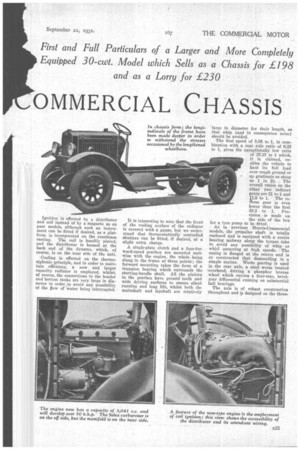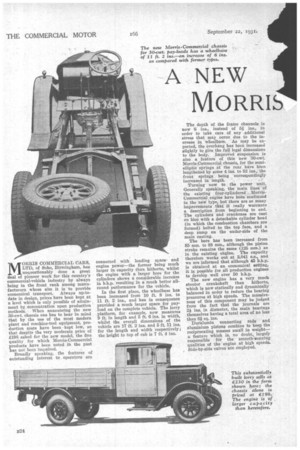OMMERCIAL CHASSIS
Page 43

Page 42

Page 44

If you've noticed an error in this article please click here to report it so we can fix it.
MORRIS COMMERCIAL CARS, LTD, of Soho, Birmingham, has unquestionably done a great deal of pioneer work for this country's commercial-vehicle industry by always being in the front rank among manufacturers whose aim it is to provide economical transport. Always up-todate in design, prices have been kept at a level which is only possible of attainment by concentration upon production methods. When announcing the new 30-cwt, chassis one has to bear in mind that by the use of the most modern plant and machine-tool equipment, production costs have been kept low, so that despite the very moderate price of £198 asked for the new model, the fine quality for which Morris-Commercial products have been noted in the past as not been impaired.
Broadly speaking, the features of outstanding interest to operators are
connected with loading spaceand engine power—the former being much larger in capacity than hitherto, whilst the engine with a larger bore for the cylinders shows a considerable increase in b.h.p. resulting in a much better allround performance for the vehicle.
In the first place, the wheelbase has been increased from 10 ft. 8 ins. to 11 ft. 2 ins., and has in consequence provided a much larger space for payload on the complete vehicle. The lorry platform, for example, now measures 9 it. in length and 5 ft. 6 ins, in width, whilst the overall dimensions of the vehicle are 17 ft. 2 ins. and 5 ft. 11. ins. for the length and width respectively; the height to top of cab is 7 ft. 4 ins.
The depth of the frame channels is now 6 ins., instead of 5g ins., in order to take care of any additional stress that may occur due to the increase in 'wheelbase. As may be expected, the overhang has been increased slightly to give the full legal dimensions to the body. ImproVed suspension is also a feature of this new '30-cwt. Morris-Commercial chassis, for the semielliptic springs at the rear haie been lengthened by some 4 ins. to 52 ins., the front springs being 'correspondingly
increased in length. .
Turning now to the power unit. Generally speaking, the main lines 'of the existing four-cylindered MorrisCommercial engine have been continued in the new type, but there are so many improvementsthat it really warrants a description from beginning to end. The cylinders and crankcase are cast en bloc with a detachable cylinder head (in which the combustion chambers are formed) bolted to the top face, and a deep sump on the under-side of the main casting.
The bore has been increased from 85 ram. to 88 mm., although the piston stroke remains the same (125 inm.) as in the existing engine. The capacity therefore works out at 3,041 c.c., and we are informed that although 45 b.h.p. is obtained at an economical setting, it is possible for all production engines to develop well over 50 b.h.p.
The new engine has a very much stouter crankshaft than hitherto, which is now statically and dynamically balanced in order to reduce the bearing pressures at high speeds. The massiveness of this component may be judged from the fact that the journals are 2k ins, in diameter, the main bearings themselves having a total area of no less than 8g sq. ins. Duralumin connecting rods and aluminium pistons combine to keep the reciprocating masses small in weight— a feature which is, no doubt, largely responsible for the smooth-tsunning qualities of the engine at high speeds. , Side-by-side valves are employed.
Ignition is effected by a distributor and coil instead of by a magneto as on past models, although such an instrument can be fitted if desired, as a platform is incorporated on the crankcase
casting. The coil is handily placed, and the distributor is housed at the back end of the dynamo, which, of course, is on the near side of the unit.
Cooling is effected on the therrnosiphonic principle, and in order to maintain efficiency, a new and larger capacity radiator is employed, whilst, of course, the connections to the header and bottom tanks are very large in diameter in order to avoid any possibility of the Dow of water being interrupted. It is interesting to note that the front of the cooling surface of the radiator is covered with a gauze, but we understand that thermostatically controlled shutters can be fitted, if desired, at a slight extra charge.
A single-plate clutch and a four-forward-speed gearbox are monnted unitwise with the engine, the whole being slung in the frame at three points; the forward mounting takes the form of a trunnion bearing which surrounds the starting-handle shaft. All the pinions in the gearbox have ground teeth and wide driving surfaces to ensure silent running and long life, whilst both the mainshaft and layshaft are relatively' large in diameter for their length, so that whip (and in consequence noise) should be avoided.
The first speed of 5.98 to 1, in combination with a rear axle ratio of 6.2-5 to 1, gives the exceptionally low ratio of 37.37 to 1 which, it is claimed, enables the vehicle to haul its full load over rough ground or up gradients as steep as 1 in 2. The overall ratios On the other two indirect gears are 21 to 1 and 11.5 to 1. The rePerse gear is even lower than the first 38.3 to 1. Provision is made on the side of the box
for a tyre pump to be fitted. •
As in previous Morris-Commercial models, the propeller shaft is totally enclosed and is equipped with a centre bearing midway along the torque tube to avoid any possibility of whip or whirl occurring at high speeds. The casing is flanged at the centre and is so constructed that dismantling is a simple matter. Worm gearing is used in the rear axle, a steel worm located
■ overhead, driving a phosphor bronze wheel which carries a four-star, bevelgear differential running on substantial ball bearings.
The axle is of robust construction throughout and ks designed on the three quarter floating principle with splined shafts of no less than 2-in. diameter. An accessible oil filler is located at the correct height for the lubricant and so prevents over-filling.
Totally enclosed brake drums of 15-in, diameter are fitted to the rear axle and side-by-side shoes are operated respectively by the pedal and hand lever. The familiar hook-up which has obtained on Morris-Commercial vehicles for some time is continued on this 30cwt. model also, but an improved form of lubrication system is now provided. There is only one cross-shaft common to both hand and foot systems ; the levers for the former mechanism are carried on a secondary tube embracing the shaft connected to the pedal.
Various points of the mechanism which require attention with the grease gun are brought into convenient positions by extension pipes.
An exceptionally full equipment is provided, such items as a 12-volt, fivelamp lighting and starting set, an electric horn, an automatic rear "stop" light, a spare wheel and tyre, a speedo
meter, an observation mirror and an automatic screen wiper being included.
Various body types are available, the lorry (the dimensions of which have already been given) being a thoroughly sturdy job constructed of hardwood, with hinged sides and tailboard. The price, as already stated, is £230.
The internal dimensions of the van body are, of course, slightly smaller than those of the lorry already described. They are actually 8 ft. 6 ins. (length), 4 ft. 8 ins. (width) and 4 ft. 5 ins. (height), giving overall dimensions of 16 ft. 6 ins. (length) and 5 ft. 11 ins. (width) ; the height to the centre of the domed roof is 7 ft. 7 ins.
Entirely enclosed, the body is panelled all over with suitable mouldings to allow for attractive colour schemes. Strong cross sticks and laths form the roof, over which is stretched rubber cloth. The price of this model is £248.
There are no fewer than four other types of vehicle available—a furniture van with inside dimensions of 9 ft. in length and 6 ft. by 6 ft. in width and height at £280, an end tipper at £245, a tilt van, with body dimensions similar to those of the furniture van, priced at £275, whilst a farm and estate lorry, also measuring 9 ft. by 6 ft. by 6 ft., is available at £270.




































































































